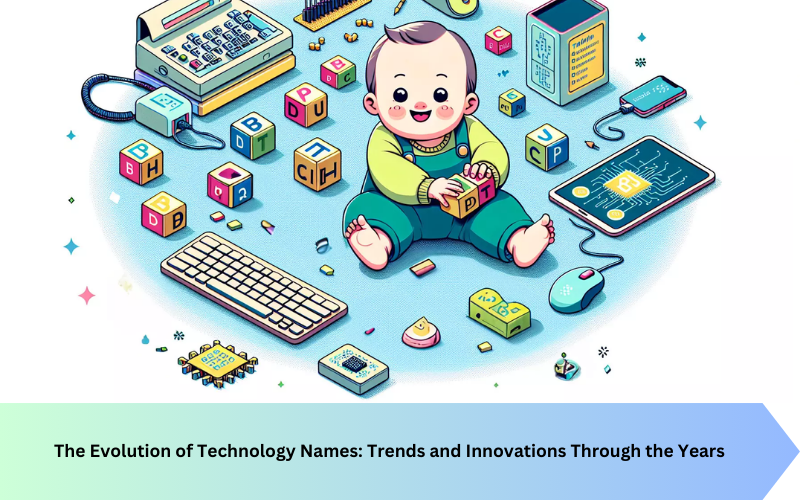Introduction to the Evolution of Technology Names
The world of technology is constantly evolving, and with it comes a fascinating transformation in the names we use to describe these innovations. From the early days of clunky acronyms to today’s catchy phrases, technology-related names have taken on a life of their own. Each era reflects not only advancements in tech but also how society perceives and interacts with these tools. It’s more than just naming; it’s about branding, identity, and connection. Join us as we explore this captivating journey through time!
The Early Days: From Acronyms to Descriptive Names
In the early days of technology, names were often steeped in functionality. Acronyms reigned supreme. Think about the likes of RAM and CPU. They conveyed purpose succinctly.
As computers emerged, so did descriptive names that painted a clear picture of their capabilities. The term “mainframe” captured the essence of these powerhouses dominating data processing during their heyday.
This approach made communication easier among tech-savvy users. It allowed them to understand complex systems at a glance. Names like “modem,” short for modulator-demodulator, explained precisely what these devices did.
However, as technology evolved and seeped into everyday life, it became apparent that more appealing branding was needed. The transition from pragmatic naming reflected not just utility but also a recognition that consumers craved connection with innovation—a shift that would pave the way for future trends in technology related names.
The 2000s: A Shift towards Catchy and Memorable Names
The 2000s marked a significant transformation in how technology related names were crafted. Gone were the days of dry acronyms and lengthy descriptions. Instead, companies began to embrace catchy and memorable monikers.
Think about brands like Google, Apple, and Yahoo! These names not only stand out but also invoke curiosity. They are easy to remember and fun to say. This era saw businesses recognizing the power of branding through effective naming strategies.
Tech products became synonymous with creativity. Names like Skype or Flickr brought a sense of playfulness into the digital world. Such innovation appealed directly to consumers, making tech feel more accessible.
This trend also paved the way for startups that focused on unique identities over traditional naming conventions. It wasn’t just about functionality anymore; it was about creating an emotional connection through vibrant names that resonated with users’ experiences.
Present Day: A Mixture of Descriptive and Creative Names
Today, technology related names reflect a fascinating blend of both descriptive and creative elements. Companies strive to convey their purpose while simultaneously invoking curiosity.
Take software applications, for instance. Names like “Slack” or “Zoom” are catchy yet hint at communication and connectivity. These titles invite users in without overwhelming them with jargon.
On the hardware front, we see an array of inventive choices alongside straightforward descriptors. Think about devices like the “Nest” thermostat—its name evokes warmth and home comfort while cleverly signaling its smart capabilities.
This duality allows brands to capture attention in a crowded marketplace. A well-chosen name can evoke emotions, spark interest, or create immediate recognition among consumers eager for innovation.
As trends shift rapidly in tech landscapes, this mix promises dynamic opportunities for new ideas and ventures emerging today. The balance between clarity and creativity continues to shape how we perceive modern technology brands.
Trending Innovations in Technology Naming
The landscape of technology-related names is evolving rapidly. New trends are emerging, often inspired by cultural shifts and advances in artificial intelligence.
One notable trend is the adoption of single-word brand names. Think “Zoom” or “Slack.” These concise options resonate well with users seeking simplicity in a complex digital world.
Another innovation involves blending words to create unique terms. Names like “Cybertruck” combine familiar concepts, evoking excitement while remaining descriptive.
Additionally, tech companies are increasingly turning to nature and emotion for inspiration. Terms that evoke feelings—like “Nest”—tap into human connections, making products more relatable.
Many brands are embracing playful language or puns. This approach not only grabs attention but also fosters a sense of community among users who appreciate clever naming strategies.
Impact of Technology Naming on Branding and Marketing
The impact of technology naming on branding and marketing cannot be overstated. A well-chosen name can evoke emotions, convey functionality, and create a lasting impression.
Consider how brands like Apple or Google have become synonymous with innovation. Their names are simple yet powerful, making them easily recognizable across the globe.
Conversely, a poorly named product can confuse potential users and dilute brand identity. For instance, overly complex or technical names may deter consumers who seek clarity.
Clever wordplay or alliteration can further enhance memorability. Brands that embrace creativity in their naming strategies often see increased engagement and loyalty from customers.
In today’s competitive landscape, the right name not only attracts attention but also builds trust. As technology continues to evolve rapidly, so too must our approach to crafting memorable technology related names.
Conclusion
The evolution of technology names reveals much about our changing relationship with innovation. From the early reliance on acronyms and descriptive labels to today’s focus on catchy, memorable titles, naming conventions reflect societal trends and marketing strategies.
As technology continues to advance rapidly, so too will the names we give it. They serve not only as identifiers but also as powerful tools for branding and connection. As businesses strive for recognition in a crowded market, understanding the nuances of tech-related naming becomes crucial.
Embracing creativity while honoring clarity can lead to successful brand identities that resonate with consumers. The landscape of technology-related names will undoubtedly continue to evolve, mirroring technological advancements and cultural shifts along the way.





